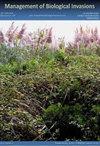Evaluation of dissolved carbon dioxide to stimulate emergence of red swamp crayfish Procambarus clarkii (Decapoda: Cambaridae) from infested ponds
IF 1.2
4区 环境科学与生态学
Q3 BIODIVERSITY CONSERVATION
引用次数: 2
Abstract
Invasive crayfish have adverse effects on habitats and native species. Control of invasive crayfish populations is a major challenge facing natural resource managers. This study evaluated the effectiveness and optimal conditions for the control agent carbon dioxide (CO 2 ), which can be diffused into water to facilitate capture of red swamp crayfish ( Procambarus clarkii ; RSC). The efficacy of CO 2 shows promise in its use for a variety of invasive aquatic species. Here, we evaluate CO 2 ’s ability to stimulate movements towards the shoreline and/or induce complete terrestrial emergence from outdoor ponds. Twelve pond trials were conducted using three, 0.02-ha experimental ponds at Auburn University, Alabama, USA. Silt fencing was installed on dry land around the perimeter of each pond with the lower 0.3 m of fencing accordion-folded to provide shelter and a collection point for emerging crayfish. Each pond was stocked with 100 RSC before testing. Experimental treatment ponds were then injected with gaseous CO 2 using porous air diffusers, whereas control ponds (C ponds) received no CO 2 . Multiple water quality parameters were monitored hourly. Three independent treatment scenarios with CO 2 diffusion were crayfish captured at the end of trial only (F: final), crayfish captured hourly (H: hourly), and incorporation of continuous inflow of fresh water at a flow rate of 0.2 L/s into the central catch basin to serve as a refuge with crayfish captured hourly (R: refuge). In control ponds, crayfish were captured at the end of trial only. In F ponds, CO 2 diffusion for approximately five hours caused a mean of 12% of total crayfish to emerge from the water. However, capture efficiency was increased to a mean of 45% of total crayfish by increasing collection frequency to every hour and netting submerged crayfish near the water edge in addition to capturing terrestrially emerged crayfish. Presence of a freshwater inflow reduced capture efficiency in R ponds relative to H ponds. Odds of capturing crayfish increased with increasing water temperature, CO 2 concentration, crayfish mass, and with decreasing pH. Based on results, we provide a set of predictive equations as well as interactive calculators to help natural resource managers explore several environmental and treatment-related scenarios that predict changes in capture probability in small research ponds. Carbon dioxide shows promises as a tool to increase capture rate of RSC. It is not likely to be 100% effective by itself, but could be a useful component of an integrated management strategy.溶解的二氧化碳刺激克氏原螯虾(十足目:坎贝科)从受感染的池塘中出现的评估
入侵小龙虾对栖息地和本地物种有不利影响。控制入侵小龙虾种群是自然资源管理者面临的一项重大挑战。本研究评估了控制剂二氧化碳(CO2)的有效性和最佳条件,该控制剂可以扩散到水中,以促进捕获红沼泽小龙虾(克氏原螯虾;RSC)。CO2的功效显示出对多种入侵水生物种的应用前景。在这里,我们评估了二氧化碳刺激向海岸线移动和/或从室外池塘诱导陆地完全浮出水面的能力。使用美国阿拉巴马州奥本大学的三个0.02公顷的实验池塘进行了12次池塘试验。在每个池塘周围的旱地上安装了淤泥围栏,较低的0.3米围栏手风琴折叠起来,为新出现的小龙虾提供庇护和收集点。在测试之前,每个池塘都储存了100个RSC。然后使用多孔空气扩散器向实验处理池注入气态CO2,而对照池(C池)不接收CO2。每小时监测多个水质参数。CO 2扩散的三种独立处理方案是仅在试验结束时捕获小龙虾(F:最终),每小时捕获小龙虾,以及以0.2 L/s的流速将淡水连续流入中央捕获池,作为每小时捕获的小龙虾的避难所(R:避难所)。在对照池塘中,小龙虾仅在试验结束时被捕获。在F池塘中,CO2扩散约5小时后,平均有12%的小龙虾从水中浮出水面。然而,通过将采集频率提高到每小时一次,并在水边捕获淹没的小龙虾,以及捕获陆地上出现的小龙虾外,捕获效率提高到平均占总小龙虾的45%。淡水流入的存在降低了R池相对于H池的捕获效率。捕获小龙虾的几率随着水温、二氧化碳浓度、小龙虾质量的增加和pH值的降低而增加。根据结果,我们提供了一组预测方程和交互式计算器,以帮助自然资源管理者探索几种环境和处理相关的场景,预测小型研究池塘捕获概率的变化。二氧化碳有望成为提高RSC捕获率的工具。它本身不太可能100%有效,但可能是综合管理战略的一个有用组成部分。
本文章由计算机程序翻译,如有差异,请以英文原文为准。
求助全文
约1分钟内获得全文
求助全文
来源期刊

Management of Biological Invasions
Agricultural and Biological Sciences-Ecology, Evolution, Behavior and Systematics
CiteScore
3.40
自引率
6.70%
发文量
21
审稿时长
16 weeks
期刊介绍:
Management of Biological Invasions, established in 2010 by Dr. Elias Dana, is an open access, peer-reviewed international journal focusing on applied research in biological invasions in aquatic and terrestrial ecosystems from around the world. This journal is devoted to bridging the gap between scientific research and the use of science in decision-making, regulation and management in the area of invasive species introduction and biodiversity conservation.
Managing biological invasions is a crisis science, with Management of Biological Invasions aiming to provide insights to the issues, to document new forms of detection, measurements and analysis, and to document tangible solutions to this problem.
In addition to original research on applied issues, Management of Biological Invasions publishes technical reports on new management technologies of invasive species and also the proceedings of relevant international meetings. As a platform to encourage informed discussion on matters of national and international importance, we publish viewpoint papers that highlight emerging issues, showcase initiatives, and present opinions of leading researchers.
 求助内容:
求助内容: 应助结果提醒方式:
应助结果提醒方式:


